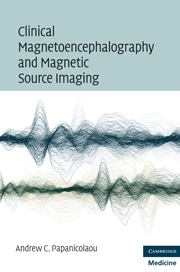Book contents
- Frontmatter
- Contents
- Contributors
- Preface
- Section 1 The method
- 1 Basic concepts
- 2 The nature and origin of magnetic signals
- 3 Recording the magnetic flux
- 4 Overview of MSI using the single equivalent current dipole (ECD) model as an example
- 5 The fundamental problems of MSI
- 6 Head models
- 7 Source models – discrete source models
- 8 Source models – distributed source models
- 9 Source models – beamformers
- 10 Pragmatic features of the clinical use of MEG/MSI
- Section 2 Spontaneous brain activity
- Section 3 Evoked magnetic fields
- Postscript: Future applications of clinical MEG
- References
- Index
7 - Source models – discrete source models
from Section 1 - The method
Published online by Cambridge University Press: 01 March 2010
- Frontmatter
- Contents
- Contributors
- Preface
- Section 1 The method
- 1 Basic concepts
- 2 The nature and origin of magnetic signals
- 3 Recording the magnetic flux
- 4 Overview of MSI using the single equivalent current dipole (ECD) model as an example
- 5 The fundamental problems of MSI
- 6 Head models
- 7 Source models – discrete source models
- 8 Source models – distributed source models
- 9 Source models – beamformers
- 10 Pragmatic features of the clinical use of MEG/MSI
- Section 2 Spontaneous brain activity
- Section 3 Evoked magnetic fields
- Postscript: Future applications of clinical MEG
- References
- Index
Summary
Both a head model and a source model are required for solving the forward problem (see Chapter 5). The source model specifies the current generator(s) that represents the estimated current source(s) and provides the foundation for obtaining a unique solution. One option is to specify only one – or a small number of – equivalent current dipole(s) (ECDs) to represent the solution. The use of few or individual ECDs for “dipole fitting” characterizes the discrete source model. A distributed source model, on the other hand, entails using large numbers (typically thousands) of ECDs distributed at known locations on either 2-D or 3-D lattices. The 2-D lattice represents the cortical surface as a triangular tessellation, i.e., tiling of the cortex with triangular elements, with ECDs at each of the vertices. These surface ECDs are generally oriented normal (parallel) to the surface. A 3-D lattice is an approximation to the brain volume, i.e., the cortical gray matter, and uses a tetrahedral or hexahedral representation with a set of omnidirectional dipoles at each vertex point. These source models are used in conjunction with minimum-norm and beamformer methods (described in later sections).
Mathematically, the source estimation problem is most commonly solved as a “global error minimization” problem (but see below for an alternative view when using beamformers). Such a problem involves the following. Given a set of measurements, find a set of sources that best accounts for the surface measurements in their entirety, in the sense that the difference between the surface magnetic activity predicted by the postulated sources and the actual (as a solution to the forward problem) recorded magnetic activity on the head surface is minimal.
- Type
- Chapter
- Information
- Publisher: Cambridge University PressPrint publication year: 2009

